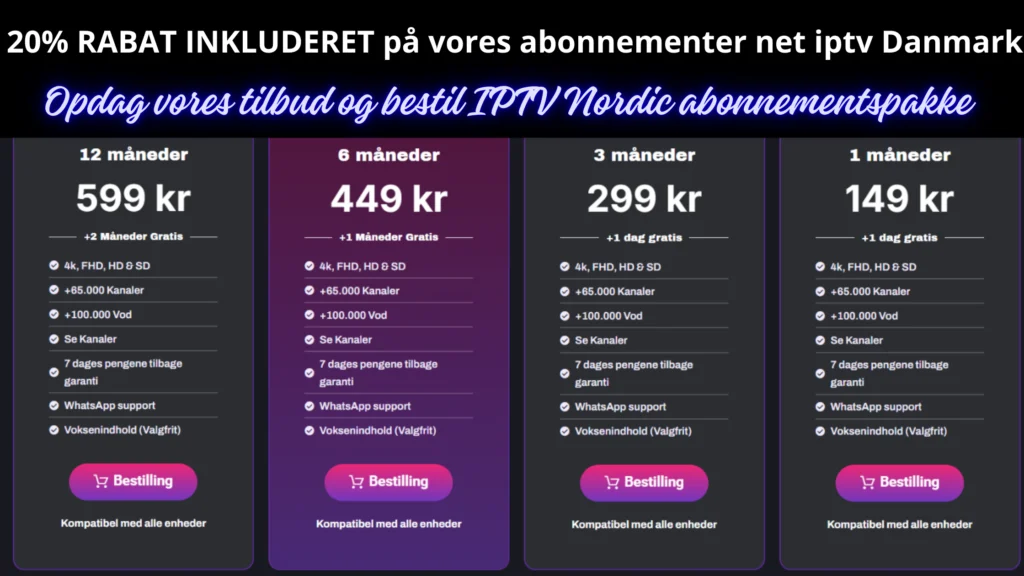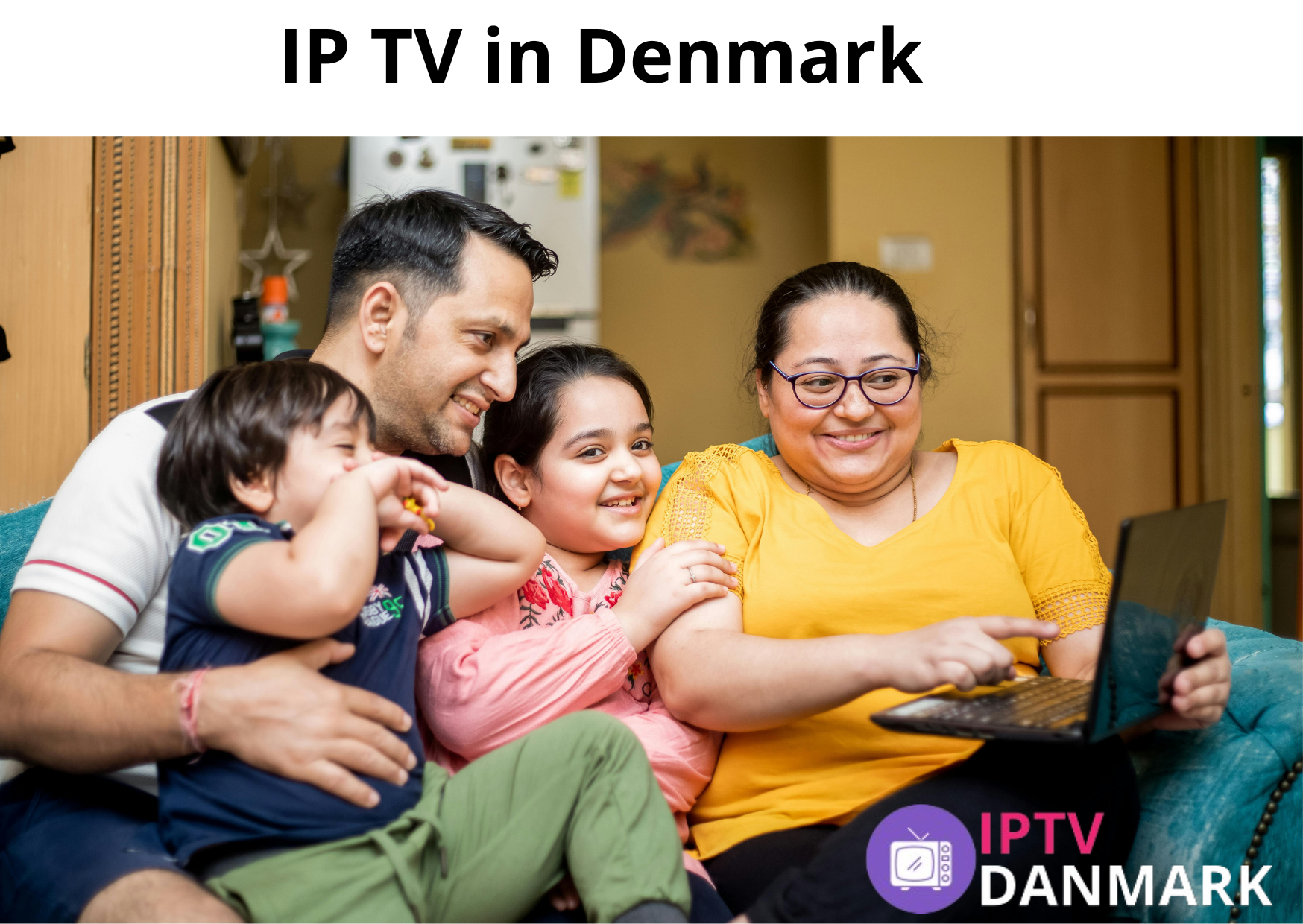Introduction to IP TV in Denmark
- Technology:
IPTV, or Internet Protocol Television, has fundamentally changed how Danish viewers consume media by streaming television content over the internet instead of through traditional broadcast or cable. IPTV enables users to access live TV, on-demand shows, and interactive services. Unlike traditional TV, which relies on broadcast signals or cables, IPTV transmits data packets over the internet, requiring a stable and high-speed connection. - Growth and Popularity of IPTV in Denmark:
Denmark has seen significant growth in IPTV adoption as viewers seek more flexible, interactive, and personalized viewing options. The country’s high internet penetration, combined with demand for digital and mobile solutions, has propelled IPTV as a preferred choice. Danish telecom operators like TDC Group, YouSee, and Waoo offer IPTV services, catering to a diverse customer base across the country. - Comparison with Traditional Broadcasting in Denmark:
While traditional broadcasting is still prevalent, IPTV offers distinct advantages, including video on demand (VOD), catch-up TV, and enhanced user control over content. In contrast to the rigid programming schedules of traditional TV, IPTV allows viewers to select content at their convenience, often with higher definition options, making it especially appealing in Denmark’s tech-savvy landscape.

Understanding Bandwidth for IPTV
- Definition of Bandwidth and Its Importance for Streaming:
Bandwidth is the amount of data that can be transferred from one point to another over a network within a specific timeframe, typically measured in Mbps (megabits per second). Higher bandwidth allows for smoother and higher-quality streaming experiences. For IPTV, especially in HD and 4K, adequate bandwidth is crucial to prevent issues like buffering, lag, or poor resolution, which degrade the viewing experience. - How Bandwidth Affects IPTV Quality:
IPTV quality is highly dependent on bandwidth. Insufficient bandwidth results in interruptions, image pixelation, and reduced video quality. IPTV relies on a continuous data stream to deliver content; any disruptions can cause buffering, which is particularly disruptive during live sports or entertainment streaming. - Minimum Bandwidth Requirements for IPTV Services:
IPTV providers typically recommend specific minimum speeds: approximately 5 Mbps for SD (standard definition), 10 Mbps for HD, and 20-25 Mbps for 4K. These numbers can vary based on compression technology and streaming protocols, but as a rule, higher-definition content requires higher bandwidth for smooth delivery.
Bandwidth Requirements for HD and 4K IPTV Streaming
- Bandwidth Needs for Standard-Definition (SD) IPTV:
For SD quality, a minimum of 1-3 Mbps is typically sufficient, making it accessible even for viewers with slower internet connections. However, as viewers increasingly expect high-definition visuals, SD has become less common for IPTV services in Denmark, where HD and 4K are in high demand. - HD Streaming: Recommended Speeds and Stability:
HD streaming typically requires a consistent bandwidth of 5-8 Mbps. While this quality is a popular choice for Danish users due to its balance of visual clarity and moderate data usage, maintaining stable speeds is key to preventing interruptions. The stability of the connection is as essential as the bandwidth itself. - 4K and Ultra HD Streaming: Advanced Bandwidth Needs:
Streaming in 4K or Ultra HD demands substantial bandwidth, often 20-25 Mbps or more, to deliver the sharpest image and most immersive experience. Danish IPTV providers increasingly offer 4K options as the country’s broadband infrastructure improves, but this requires subscribers to have fast, reliable connections to enjoy the full benefits without buffering.
Factors Affecting Bandwidth Requirements in Denmark
- Impact of Household Internet Usage on :
The number of devices connected to the internet simultaneously affects available bandwidth. In a typical Danish household, streaming on multiple devices, online gaming, and downloading large files can reduce the bandwidth available for IPTV, leading to potential quality drops. - Role of Internet Service Providers (ISPs) in Bandwidth Delivery:
Danish ISPs like TDC Group and Telenor play a critical role in maintaining and expanding broadband infrastructure to meet growing demands for IPTV. Factors such as network congestion, peak hours, and ISP bandwidth allocation policies can influence the quality of IPTV streaming services. - Geographic and Regional Bandwidth Variations within Denmark:
While urban areas in Denmark generally enjoy high-speed internet, rural regions may experience limitations due to infrastructure gaps. The government has ongoing initiatives to bridge this digital divide, which is essential for ensuring equitable IPTV access across Denmark.
Internet Connection Types and IPTV Performance
- Fiber-Optic Connections and Their Benefits for IPTV:
Fiber-optic internet, known for its high speed and stability, is the gold standard for IPTV. In Denmark, fiber is widely available in urban areas, allowing seamless HD and 4K streaming experiences. Fiber connections minimize latency and offer high data rates, supporting multiple devices simultaneously. - DSL and Cable Internet: Limitations and Challenges:
DSL and cable connections, while widely used, may not provide consistent bandwidth for IPTV, especially for HD or 4K streaming. These types of connections are often more vulnerable to speed drops during peak usage times, which can affect streaming quality. - Mobile Networks (4G/5G) for IPTV Streaming in Denmark:
With 5G rollout accelerating in Denmark, mobile networks are becoming viable options for IPTV streaming. However, data caps and network coverage remain considerations, particularly in remote areas. While 5G promises high speeds, 4G may still be limited for high-definition streaming due to latency and capacity constraints.
Recommended Bandwidth for Different IPTV Services
- Bandwidth Guidelines for Live TV Streaming:
Live streaming is bandwidth-intensive, particularly for high-definition broadcasts. A stable 10 Mbps connection is generally recommended for HD live streaming, whereas 4K live events may require at least 25 Mbps to ensure smooth, uninterrupted streaming. - On-Demand and Catch-Up Services: Data Usage and Needs:
On-demand services like movies and TV shows generally require less bandwidth consistency than live streams, as they can buffer ahead. However, HD and 4K on-demand content will still require substantial bandwidth to maintain picture quality, particularly if several viewers in a household are streaming simultaneously. - Multi-Device Streaming: Impact on Overall Bandwidth:
In households where multiple devices are used for IPTV at the same time, bandwidth requirements increase significantly. For instance, streaming 4K content on two devices may require upwards of 50 Mbps, especially if additional internet activities are occurring concurrently.
Optimizing Bandwidth for Seamless IPTV Experience
- Tips for Reducing Consumption:
Users can reduce their bandwidth usage by adjusting streaming quality, using Ethernet over Wi-Fi for a more stable connection, and limiting background applications that consume data. - Network Optimization Strategies for Danish Households:
Upgrading routers, positioning them centrally, and considering Wi-Fi extenders can significantly enhance network performance. Mesh Wi-Fi systems are another option for larger homes, providing consistent internet coverage and improving IPTV streaming quality. - Choosing the Right ISP Plan for IPTV Needs:
Danish viewers should evaluate ISP plans based on their streaming habits. Plans offering higher speeds and unlimited data are recommended for frequent HD or 4K IPTV users to avoid disruptions and data overages.

Bandwidth Usage and Data Caps in Denmark
- Understanding Data Caps and Fair Usage Policies:
Some Danish ISPs enforce data caps, particularly on mobile data plans, which can limit the amount of HD or 4K IPTV streaming. Understanding these caps is essential to prevent unexpected data throttling. - How Data Limits Affect IPTV Users in Denmark:
Data caps can significantly impact IPTV streaming, especially for households using IPTV as their primary TV service. Exceeding data limits may lead to additional charges or speed reductions, affecting viewing quality. - Options for Unlimited Data Plans from Danish ISPs:
Many ISPs in Denmark offer unlimited data options, which are ideal for IPTV households. Unlimited plans provide a stable and worry-free viewing experience, enabling families to enjoy IPTV without constraints.
Future Trends: Bandwidth Demand for Next-Gen IPTV
- Projected Bandwidth Requirements for Advanced IPTV Technologies:
Emerging IPTV services, including interactive features and immersive formats, are expected to increase bandwidth requirements. Viewers may need upwards of 50 Mbps for optimal experiences in high-definition or interactive environments. - Emerging Technologies and Their Impact on Bandwidth (e.g., VR, 8K):
VR and 8K technologies represent the next frontier in IPTV. Streaming in 8K could demand bandwidth exceeding 100 Mbps, while VR applications might require similar speeds for a seamless experience, highlighting the importance of continued investment in infrastructure. - Denmark’s Infrastructure Readiness for Future IPTV Needs:
Denmark’s commitment to expanding fiber and 5G networks positions it well for future IPTV demands. Government and ISP initiatives are focused on providing robust infrastructure to support high-bandwidth applications.
Conclusion: Meeting Denmark’s Bandwidth Needs for IPTV
- Summary of Key Points:
With IPTV growing rapidly in Denmark, bandwidth needs have become critical. Ensuring adequate speeds for various streaming options, from SD to 4K, is essential for a satisfying viewing experience. - Future Prospects and Recommendations for Danish IPTV Users:
As bandwidth demands increase, Danish IPTV users should consider investing in higher-speed plans and modern network equipment to meet future requirements. - The Path Forward for Denmark’s IPTV Landscape:
Denmark’s focus on technological advancements and infrastructure improvements provides a strong foundation for IPTV growth. The future of IPTV in Denmark looks promising as the country continues to enhance its digital capabilities. IP TV in Denmark The Path Forward for Denmark’s IPTV Landscape:
Denmark’s focus on technological advancements and infrastructure improvements provides a strong foundation for IPTV growth. The future of IPTV in Denmark looks promising as the country continues to enhance its digital capabilities. IP TV in Denmark IPTV in Denmark IPTV in Denmark The Path Forward for Denmark’s IPTV Landscape:
Denmark’s focus on technological advancements and infrastructure improvements provides a strong foundation for IPTV growth. The future of IPTV in Denmark looks promising as the country continues to enhance its digital capabilities IP TV in Denmark IPTV in Denmark IPTV in Denmark The Path Forward for Denmark’s IPTV Landscape:
Denmark’s focus on technological advancements and infrastructure improvements provides a strong foundation for IPTV growth. The future of IPTV in Denmark looks promising as the country continues to enhance its digital capabilities IP TV in Denmark IPTV in Denmark IPTV in Denmark The Path Forward for Denmark’s IPTV Landscape:
Denmark’s focus on technological advancements and infrastructure improvements provides a strong foundation for IPTV growth. The future of IPTV in Denmark looks promising as the country continues to enhance its digital capabilities. IP TV in Denmark IP TV in Denmark IP TV in Denmark IP TV in DenmarkIP TV in Denmark IP TV in Denmark IP TV in Denmark IP TV in Denmark IP TV in Denmark IP TV in Denmark IP TV in Denmark IP TV in Denmark IP TV in Denmark
This draft provides a detailed structure with content for each heading. Let me know if you’d like to proceed with any section or need additional details!
4o

